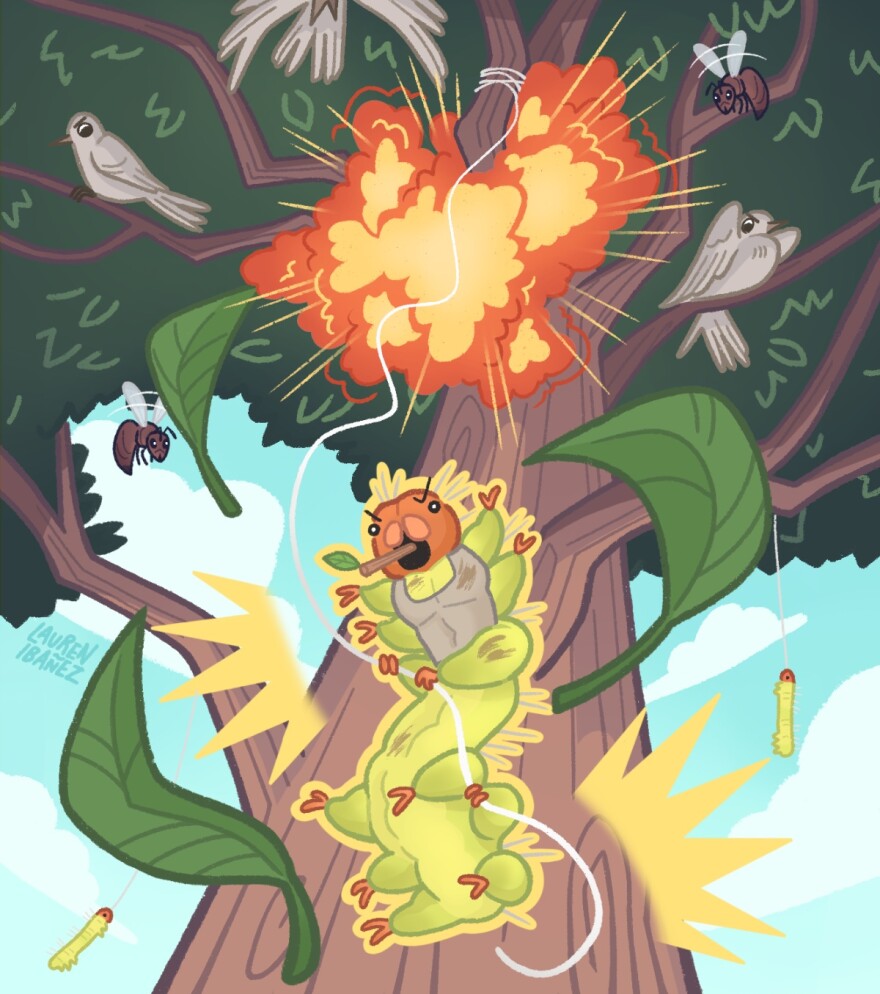If you’ve spent any time outside under a tree — or even walking outside your front door — in the past couple weeks, you may have noticed all the inchworms. They’re hanging in midair by a thin thread, blowing in the breeze. You may have snagged a few of them on your shirt only to find them crawling on your neck a little while later.
Estelle Fisher thought there were more of them than usual this year.
“They’re all over the place,” she says. “And I was just curious why this year and what they’re doing — are they eating my trees?”
And why are they dangling from those threads? Don’t they just get picked off by the birds?
Estelle asked ATXplained whether there are, in fact, more of them this year in Central Texas and why they do their trapeze act.
Remember that scene near the end of "Die Hard," where the terrorists blow up the roof? Well, their acrobatics are kinda like that.
To find answers to Estelle’s questions, I went on a caterpillar hunt with an entomologist named Mike Quinn. We went to a wooded area near his house in Southwest Austin. He uses this canvas bag on a stick, kind of like a bug net, to sweep through the branches of a tree.
When he opens it up, there are at least half a dozen inchworms, plus some other caterpillars and bugs.

“Yeah, this is entomological Christmas,” he says.
Inchworms are a subset of caterpillars. They have legs only near their head and tails, which is why they inch to move, while caterpillars have legs all down their bodies. These inchworms are from a family of caterpillars called geometridae. The worms shed their skins several times, grow larger and eventually form a cocoon and turn into moths.
March and April are typically prime time for inchworms in Central Texas. They thrive on the fresh leaves that trees are putting out this time of year. So why are there so many this spring?
It might have something to do with February’s winter storm.
“This extreme cold weather in February probably knocked back a lot of the insects that would be enemies of these things,” says Larry Gilbert, a professor of integrative biology and the director of the Brackenridge Field Lab at UT Austin.
Inchworms tend to lay eggs underground, where they'd be more protected from the cold. The freeze might have delayed when some trees started to put out new leaves, meaning there was just a huge supply of food for caterpillars all at once later in the spring.
“Everything’s putting out leaves right together, so everything explodes together,” Gilbert says.
So about those predators. Lots of things want to eat these inchworms: birds, ants, wasps. Some wasps will just eat them; others will lay their eggs inside of the caterpillars and then eat them after the baby wasps hatch.
It’s hard out there for an inchworm.
All that danger leads to the answer to that dangling question.
“They’re not going to outrun anything, so dropping is — um, bungee jumping — is their escape mechanism,” Quinn says.
Inchworms can make a little silk thread, like spiders. They use this to attach themselves to leaves. And if things go sideways up in the tree, “these little guys bail out of there and hang down on a silk thread until the danger’s gone,” Gilbert says. “Then they crawl back up and keep eating.”
So even though you might get snagged on their threads, these inchworms are right where they want to be.
“Imagine you’re in a 6-story building and a bunch of terrorists are coming in shooting everybody,” Gilbert explains. “You get some climbing rope, you just bail out of the window and hang out there until it’s over.”
Just like in "Die Hard," when Bruce Willis is at the top of the skyscraper.
Yippee ki-yay, moths and butterflies.
Copyright 2021 KUT 90.5. To see more, visit .


